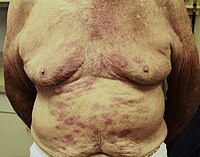
Photo from wikipedia
Background Leprosy is rare in the United Kingdom (UK), but migration from endemic countries results in new cases being diagnosed each year. We documented the clinical presentation of leprosy in… Click to show full abstract
Background Leprosy is rare in the United Kingdom (UK), but migration from endemic countries results in new cases being diagnosed each year. We documented the clinical presentation of leprosy in a non-endemic setting. Methods Demographic and clinical data on all new cases of leprosy managed in the Leprosy Clinic at the Hospital for Tropical Diseases, London between 1995 and 2018 were analysed. Results 157 individuals with a median age of 34 (range 13–85) years were included. 67.5% were male. Patients came from 34 different countries and most contracted leprosy before migrating to the UK. Eighty-two (51.6%) acquired the infection in India, Sri Lanka, Bangladesh, Nepal and Pakistan. 30 patients (19.1%) acquired leprosy in Africa, including 11 from Nigeria. Seven patients were born in Europe; three acquired their leprosy infection in Africa, three in South East Asia, and one in Europe. The mean interval between arrival in the UK and symptom onset was 5.87 years (SD 10.33), the longest time to diagnosis was 20 years. Borderline tuberculoid leprosy (n = 71, 42.0%), and lepromatous leprosy (n =, 53 33.1%) were the commonest Ridley Jopling types. Dermatologists were the specialists diagnosing leprosy most often. Individuals were treated with World Health Organization recommended drug regimens (rifampicin, dapsone and clofazimine). Conclusion Leprosy is not a disease of travellers but develops after residence in an leprosy endemic area. The number of individuals from a leprosy endemic country reflect both the leprosy prevalence and the migration rates to the United Kingdom. There are challenges in diagnosing leprosy in non-endemic areas and clinicians need to recognise the symptoms and signs of leprosy.
Journal Title: PLOS Neglected Tropical Diseases
Year Published: 2022
Link to full text (if available)
Share on Social Media: Sign Up to like & get
recommendations!